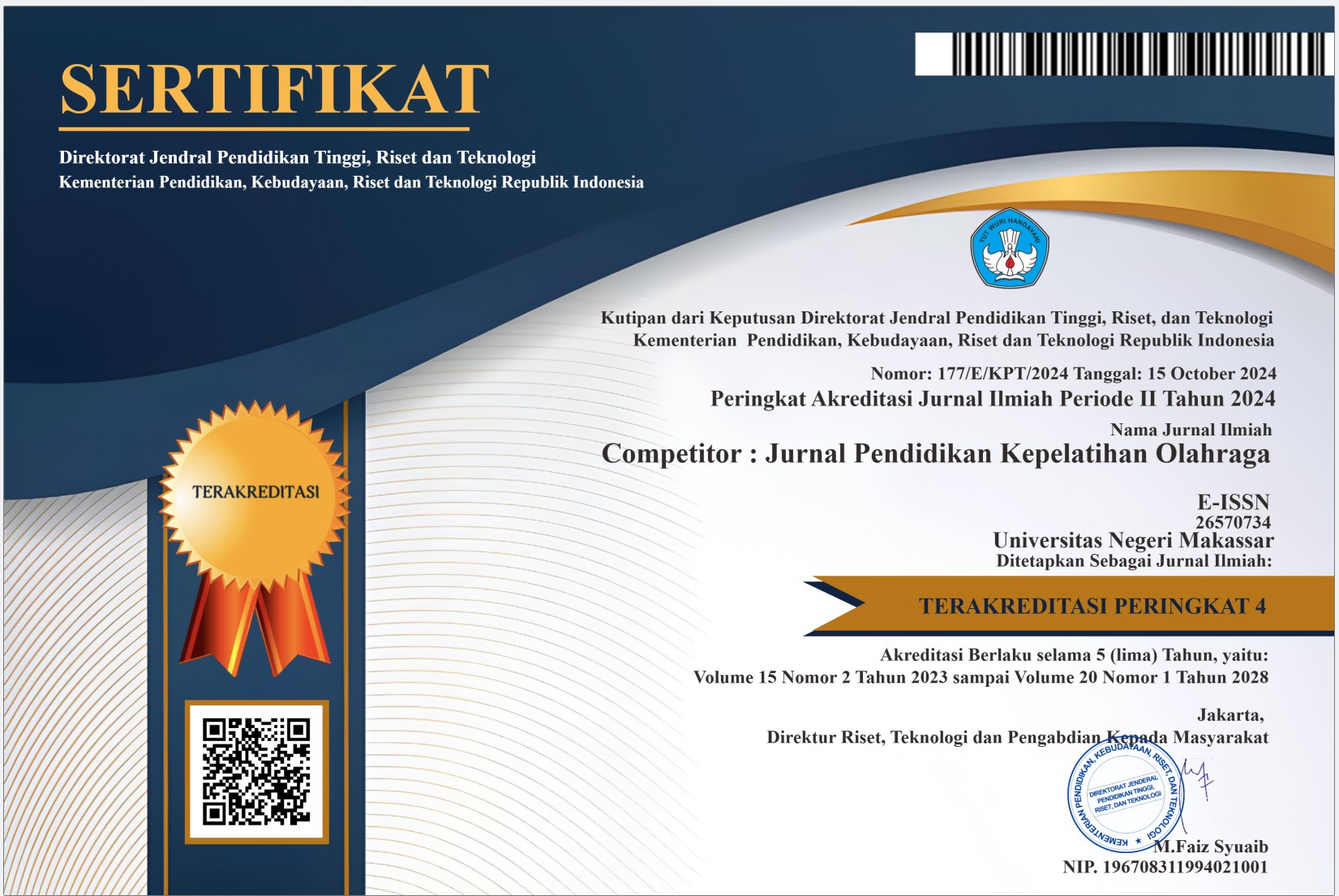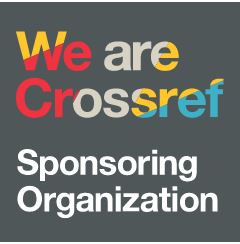Study of Differences in Physical Fitness Levels Between Male and Female Students in Class X of SMAN Madani Palu Integrated Model
DOI:
https://doi.org/10.26858/cjpko.v17i2.250Keywords:
Physical Fitness; High School Students,; TKJI; Gender Differences; Physical ActivityAbstract
This study aims to determine the level of physical fitness of male and female students in class X-A of Madani Palu Integrated Model State Senior High School, as well as to analyze the differences between the two. The method used was a quantitative descriptive survey with data collection techniques through the Indonesian Physical Fitness test (TKJI), which includes 60 60-meter run, a 1200-meter run (boys) and 1000 meters (girls), vertical jump, sit up, and hanging body lift. The population in this study amounted to 91 students, consisting of 38 male students and 53 female students, and the entire population was sampled (total sampling). The results showed that the majority of students were in the moderate physical fitness category, with details: 63.3% of male students and 88.3% of female students fell into this category. This finding indicates that there is no significant difference between male and female students in terms of physical fitness level. Factors that influence this result include the limited frequency of PE lessons, lack of physical activity outside of school, and inadequate infrastructure. A sustainable exercise program and good environmental support are needed to improve students' physical fitness.
References
Akbar, M. H. (2015). Survei Tingkat Kebugaran Jasmani Siswa Kelas X, XI dan XII SMAN 3 Nganjuk. Jurnal Pendidikan Olahraga Dan Kesehatan, 3(3), 702-708.
Arga Raka Pradana Son (2019) dengan judul Tingkat Kesegaran Jasmani Kelas Xi Sma Negeri 2 Ngaglik Kabupaten Sleman
Cadenas-Sanchez, C., Intemann, T., Labayen, I., et al. (2019). Physical fitness reference standards for European children and adolescents: The HELENA study. European Journal of Paediatrics, 178(12), 1649–1660. https://doi.org/10.1007/s00431-019-03497-y
Candra Adi Wibowo (2007). Dengan judul “Survai Tingkat Kesegaran Jasmani Siswa SMA Negeri 1 Candiroto Kabupaten Temanggung Year Pelajaran 2005/2006”
Cvenkel, N., Dolenec, R., & Jurak, G. (2019). Gender differences in physical fitness among Slovenian adolescents. Kinesiology, 51(2), 230–240.
Djoko Pekik Irianto. (2004). Bugar dan Sehat Dengan Olahraga. Yogyakarta : Andi Offse
Erminawati. 2009. Kesegaran Kesehatan. Jakarta: Ricardo
Faigenbaum, A. D., Lloyd, R. S., & Myer, G. D. (2015). Youth resistance training: Past practices, new perspectives, and future directions. Pediatric Exercise Science, 27(3), 349–366. https://doi.org/10.1123/pes.2015-0011
Farid, M. (2017). Hubungan Antara Status Gizi Dengan Tingkat Kebugaran Jasmani Siswa Kelas V SDN Kedondong I Kecamatan Tulangan Kabupaten Sidoarjo. Jurnal Pendidikan Olahraga Dan Kesehatan, 5(3), 762 - 765.
Gallotta, M. C., Emerenziani, G. P., Franciosi, E., Meucci, M., & Guidetti, L. (2020). Sex differences in physical fitness performance during adolescence: Role of sport practice. PLoS ONE, 15(7), e0236024. https://doi.org/10.1371/journal.pone.0236024
Hallal, P. C., et al. (2016). Global physical activity levels: Surveillance progress, pitfalls, and prospects. The Lancet, 380(9838), 247–257.
Hardy, L. L., Reinten-Reynolds, T., Espinel, P., Zask, A., & Okely, A. D. (2018). Prevalence and correlates of low fundamental movement skill competency in children. Paediatrics, 130(2), 390–398.
Kusumawati, M. (2015). Penelitian Penjasorkes Pendidikan Jasmani Olahraga dan Kesehatan. Bandung: Alfabeta.
Lia Cristiana (2022) dengan judul “Tingkat Kebugaran Jasmani siswa SMA Negeri 2 Kota Tasikmalaya Pasca Pandem
López-Sánchez, G. F., et al. (2021). Physical fitness profile of high school students by sex and age. International Journal of Environmental Research and Public Health, 18(14), 7551. https://doi.org/10.3390/ijerph18147551
Madjid, I. (2017). Tingkat Kesegaran Jasmani Siswa Peserta Ektrakurikuler Bolavoli Sma Negeri 1 Karanganom. Pendidikan Jasmani Kesehatan dan Rekreasi, 6(12).
Marques, A., et al. (2020). Levels of physical activity of adolescents in 28 countries. Preventive Medicine, 138, 106147. https://doi.org/10.1016/j.ypmed.2020.106147
Muhajir. (2006). Pendidikan Jasmani dan Kesehatan. Jakarta: Erlangga.
Mubarok, H. (2015). Analisis Profil Tingkat Kesegaran Jasmani Pemain Bolavoli Anker FC Year 2014 (Doctoral dissertation, Universitas Negeri Semarang).
Muliadi, M., Nur, M., & Badaru, B. (2019). Analisis Tingkat Kesegaran Jasmani terhadap Kemampuan Permainan Bolavoli siswa SMA Negeri 2 Bantaeng (Doctoral dissertation, Universitas Negeri Makassar
Nopembri, S., Mulyana, A., & Hidayat, Y. (2020). Gender-based analysis of students’ physical fitness levels in junior high school. Jurnal Keolahragaan, 8(2), 112–121. https://doi.org/10.21831/jk.v8i2.34822
Nurcahyo, E. (2014). Survei Tingkat Kesegaran Jasmani Siswa Kelas XI (Sebelas) SMA Muhammadiyah 1 Babat Kabupaten Lamongan. Jurnal Pendidikan Olahraga Dan Kesehatan, 2(1), 88-93.
Nurhasan, H & Cholil, D. Hasanudin (2014) “ Modul Tes Dan Pengukuran Keolahragaan”. Bandung: Pendidikan Kepelatihan. Fakultas Pendidikan Olahraga dan Kesehatan. Universitas Pendidikan Indonesia.
Ortega, F. B., Ruiz, J. R., Castillo, M. J., & Sjöström, M. (2015). Physical fitness in childhood and adolescence: A powerful marker of health. International Journal of Obesity, 32(1), 1–11.
Paturusi, A. (2012). Manajemen Pendidikan Jasmani dan Olahraga. Jakarta: Rineka Cipta.
Permaesih, D., Rosmalina, Y., Moeloek, D., & Herman, S. (2001). Cara praktis pendugaan tingkat kesegaran jasmani. Buletin Penelitian Kesehatan, 29(4).
Prawoto, Musan. (2007). Hubungan Tingkat Kebugaran Jasmani, Tingkat pendidikan Orang Tua Dengan Prestasi Belajar Siswa Kelas IV dan V MIN Wonosari. Skripsi. Yohyakarta : FIK UNY
Riduwan. (2005). Belajar Mudah Penelitian untuk Guru-Karyawan dan Peneliti Pemula. Bandung: Alfabeta
Setiawan. (2017). Survei Tingkat Kebugaran Jasmani Pada Kelas VII SMPN 2 Taman Kecamatan Taman Kabupaten Sidoarjo. Jurnal Pendidikan Olahraga dan Kesehatan, 5(3), 851 – 861
Setyawan, A., Wardani, R., & Subagyo, A. (2021). Factors influencing adolescent physical fitness in urban and rural schools. Jurnal Pendidikan Jasmani Indonesia, 7(1), 25–34.
Silva, G., Andersen, L. B., Aires, L., et al. (2020). Physical activity and fitness in youth: An overview of European data. European Journal of Sport Science, 20(1), 45–56.
Tomkinson, G. R., Carver, K. D., Atkinson, F., et al. (2018). European normative values for physical fitness in children and adolescents. British Journal of Sports Medicine, 52(19), 1198–1207.
Undang-Undang Republik Indonesia. (2005). Sistem Keolahragaan Nasional. Jakarta: Kemenegpora.
Wahjoedi. (2001). Landasan Evaluasi Pendidikan Jasmani. Jakarta: PT. Raja Grafindo.
Warburton, D. E. R., & Bredin, S. S. D. (2017). Health benefits of physical activity: A systematic review. Current Opinion in Cardiology, 32(5), 541–556.
WHO. (2020). Guidelines on physical activity and sedentary behaviour. World Health Organization.
Widiastuti. (2017). Tes Dan Pengukuran Olahraga. Jakarta: PT Bumi Timur Jaya.
Downloads
Published
Issue
Section
License
Copyright (c) 2025 Riski, Kamarudin, Gunawan, Muh. Saldi, Krisyanto Batong Lumbaa, M. Khairil Fajri (Author)

This work is licensed under a Creative Commons Attribution 4.0 International License.





















